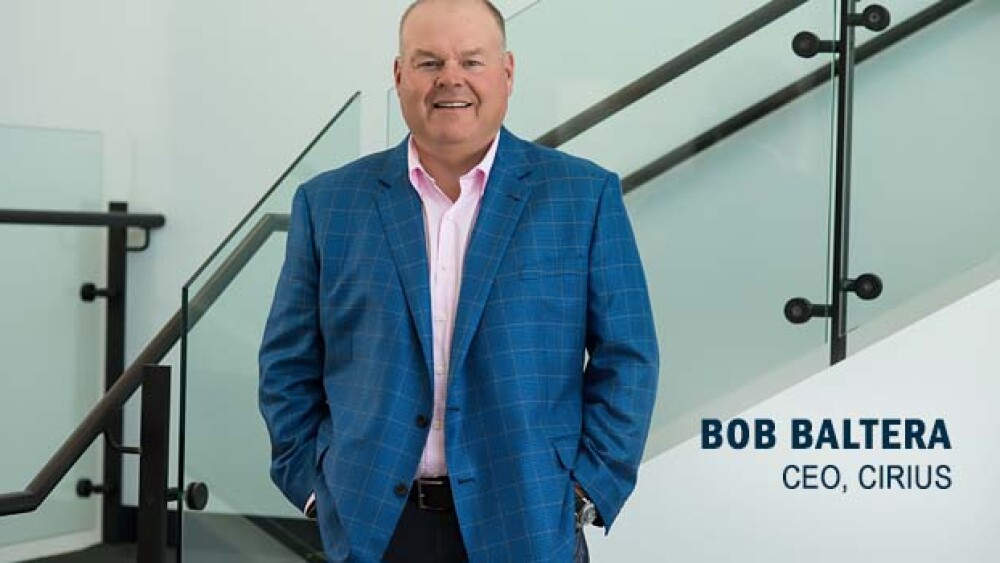With headquarters located in San Diego, Calif. and Kalamazoo, Mich., Cirius Therapeutics is a clinical-stage pharmaceutical company focused on developing a treatment for NASH.
With headquarters located in San Diego, Calif. and Kalamazoo, Mich., Cirius Therapeutics is a clinical-stage pharmaceutical company focused on developing a treatment for nonalcoholic steatohepatitis (NASH).
NASH is a complex, liver disease caused by a buildup of fat in the liver. If it becomes severe, it can cause scarring of the liver, leading to cirrhosis and possible death. There is no specific treatment for the disease aside from diet and exercise. It is conservatively estimated to affect 16 million people in the U.S. with a market size ranging from at least $10 billion to $30 or $40 billion.
Officially founded in 2016, Cirius completed a Series A financing in April 2017 of up to $40 million led by Frazier Healthcare Partners and Novo A/S. They were joined by Adams Street Partners and Renaissance Venture Capital Fund, as well as Hopen Life Sciences Ventures.
Company chief executive officer Bob Baltera told BioSpace, “The founding of Cirius was based upon the observation that the first generation of insulin sensitizers developed for Type 2 diabetes, had some safety issues. Pioglitazone was probably the safest of them all. There was some work done by a Florida researcher named Ken Cusi, who basically showed the drug had a lot of efficacy in NASH. He studied these drugs in diabetics and prediabetics who had NASH and showed impressive results. Jerry Colca, Cirius’ co-founder and vice president of research and development was involved in the early development of pioglitazone. Jerry’s data combined with the Cusi data in NASH subjects pointed to the fact that if you could dial out the affinity for PPAR-gamma you had a lot of good metabolic parameters for glycemic control.”
Which led to the development of MSDC-0602K, a next-generation insulin sensitizer that is currently in a Phase IIb for NASH.
Company Leadership
Bob Baltera — chief executive officer. Prior to joining Cirius, Baltera was chief executive officer of Laguna Pharmaceuticals and for Amira Pharmaceuticals until it was acquired by Bristol-Myers Squibb in 2011 for $475 million. Before that, he held several senior management positions at Amgen.
Jerry Colca— co-founder and vice president of Research and Development. Colca began his work with The Upjohn Company in 1984, then continued with Pharmacia after the two companies’ merger in 1993, continuing through further mergers with Pharmacia, Monsanto-Searle and Pfizer. In 2006, Colca founded MSDC, a company focused on developing drugs for metabolic diseases.
Howard Dittrich — chief medical officer. Ditttrich previously served as chief medical officer at Laguna Pharmaceuticals, Sorbent Therapeutics, Sequel Pharmaceuticals and NovaCardia. Before NovaCardia, he held executive positions at Molecular Biosystems and Alliance Pharmaceutical.
Brian Farmer — chief business officer. Previously, Farmer served as chief business officer at Laguna Pharmaceuticals and as vice president of corporate development and operations at Sequel Pharmaceuticals.
Angeline Shashlo is the vice president of Development and Julie Iwashita is the vice president of Clinical Operations.
Company Financing
Cirius raised $40 million in a Series A round in April 2017. It was led by Frazier Healthcare Partners and Novo A/S. Now, those funds will be used to complete the Phase IIb trial of MSDC-0602K and prepare for an eventual Phase III trial and potential commercialization. Baltera told BioSpace, “As an executive of a venture-backed company, you never stop thinking about raising more money, especially a biotech company that isn’t generating revenue. That said, we’re really focused on turning over this card in the clinic, to get an answer and get information and data to better inform how to move forward. Whether that means another private round, some sort of addition to a private round, setting us up for a public round or some sort of partnership to raise capital will be determined by what we learn about the drug.”
Pipeline
The company’s sole asset is MSDC-0602K, which is currently in the EMMINENCE Phase IIb clinical trial. The drug is an oral, once-daily next-generation insulin sensitizer that avoids safety problems associated with first-generation insulin sensitizers. The randomized trial is comparing three doses of MSDC-0602K to placebo in NASH patients with fibrosis. Baltera said, “Our expectation is our current Phase II study will be finished in 2019. After that, we’ll figure out the best pathway forward. We’ll have various plans for success and several plans for where we can go.”
Market Competition
NASH is an area of unmet medical need with a large patient population, so many companies are interested in it, even if they don’t quite know what to do about it. Dublin-based Allergan has made some forays into it, acquiring San Francisco-based Tobira Therapeutics in September 2016, which has two complementary development programs, Cenicriviroc (CVC) and Evogliptin, for NASH. And in same month, Allergan acquired Akarna Therapeutics, based in San Diego, along with its lead candidate for NASH.
Other big players are Gilead Sciences, Intercept, Genfit, Novo Nordisk, Shire, Novartis, Galmed and Conatus.
Baltera told BioSpace, “What’s interesting about this space, about 10 years ago if you asked big biopharma about NASH, they weren’t interested. About five years ago, it was about 50/50 and I think where we are today, I think 80 to 90 percent are interested. A lot of them, unlike Allergan and Gilead, are trying to figure out what bet to place and where. One of the hallmarks of metabolic diseases is they tend to be complicated. There’s a lot of biology and biochemistry going on.”
And because NASH is multifactorial, with a combination of insulin resistance, fibrosis, and inflammation, it’s entirely possible that an eventual treatment will be a cocktail of drugs that handle different components of the disease, not unlike what is being done in HIV and immuno-oncology.
Dollars and Deals
At the moment, Cirius is intent on using its $40 million to move the company’s asset through Phase IIb and into Phase III if possible. It is also preparing the foundations for potential commercial operations, if the company should get that far in the development of the drug. Baltera says, “We talk to everybody and we’re open to all the options. How I view it from an executive standpoint is to be agnostic where my source of funding comes from. What I try to worry about is putting the company and program in a position to most quickly advance it to help patients. Sometimes that’s to raise money, sometimes it’s to partner with a large strategic company that can help us along the way, maybe give them part of the business and keep part of the business. And sometimes it’s to graduate it and send it off to college and let them run the ball with it because they have all the manufacturing and commercial infrastructure available that I don’t currently have. So the best we can do is to get the product to a position where it’s truly Phase III-ready and that’s what we’re doing.”
What to Look For
The company has a good 12 to 18 months or more before it will have a final readout on its Phase II trial. At that point, sometime in 2019, the company will have an idea on whether the data is strong enough to move into Phase III and potential commercialization. Baltera told BioSpace, “A good idea is a comparison of 10 years ago with Hepatitis C. If you followed Gilead, the real foundation of the company is Hepatitis C, and now they’ve done such a great job in halting a disease in its tracks that NASH is becoming the number one reason for liver transplants, not Hepatitis C. It’s a growing area of need.”
See Top Life Science Startups 2018
See Top Life Science Startups 2017
See Top Life Science Startups 2016
See Top Life Science Startups 2015





